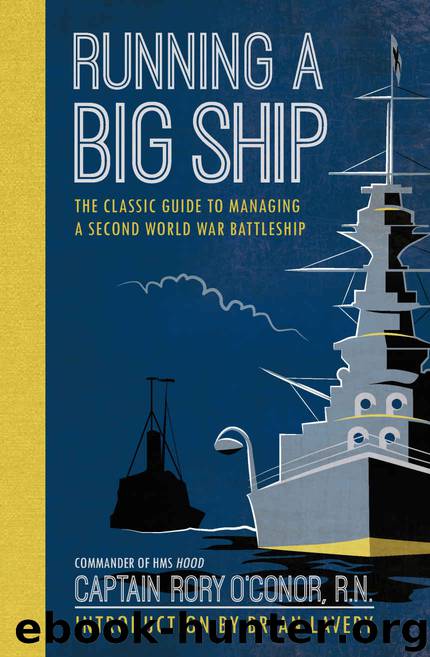Running a Big Ship: The Classic Guide to Commanding A Second World War Battleship by Rory O'Conor & Brian Lavery

Author:Rory O'Conor & Brian Lavery [O'Conor, Rory]
Language: eng
Format: azw3
ISBN: 9781612005737
Publisher: Casemate
Published: 2017-07-13T04:00:00+00:00
The propeller is designed for normal operation at planing speeds round twenty knots. Its proportions cannot, therefore, be expected to be correct for a towing speed of seven knots, which is below planing speed.
The tendency in towing will be for some excessive torque to be set up in the clutch and reverse gearbox if attempts are made to regulate engines at or near full throttle. It will be found that quite a small throttle opening will suffice for towing almost any load at reasonable speeds; it is important in the interests of the transmission gear that excessive speed while towing is not attempted.
With the above reservations, it will be found that these boats tow quite satisfactorily, and that their handling calls for no special technique.
Selecting Coxswains. (a) Required Mentality.—A slightly different mentality must be developed for the coxswains of high-speed boats, from that required to run the slower boats. In the latter the coxswain handled the steering, while an engineer handled the machinery.
The modern fast boat is usually controlled by one man, the coxswain, who, besides having charge of the steering gear, has also an engine throttle and reverse gear lever to hand, as well as the engine instruments to watch.
It is found at first that the necessity for thinking of three controls at once may give rise to confusion, but, like other controlling arrangements, once a certain amount of practice has been obtained, the necessary movements become practically automatic.
(b) Different Types of Coxswains.—Though in many ways simpler, the instruction in the driving and handling of these boats can be likened to learning to fly an aeroplane. Some individuals pick it up relatively quickly and soon become quite at home in all circumstances, while others are never really happy and are always more or less of a menace to the boat, and possibly also to its occupants. After a week, the coxswain selected should have mastered the job sufficiently to display, in all but the most trying circumstances, reasonable confidence and efficiency. If, however, he continues after this time to prove himself inept, it will save all concerned, and the boat in particular, if he is replaced by another man. Experience has proved that it is not necessarily a very young man who makes the best coxswain of these boats. In several cases a man approaching pension has proved to be suitable. The man to beware of is a man who ‘knows all about it,’ and who can be taught nothing by anybody. Though it is probably true that this applies to most walks of life, it is very much better to have the man who does not profess to have profound knowledge, but who, nevertheless, is painstaking and reliable and will ask if in doubt.
(c) Mechanical Sense.—The coxswain need not be a mechanic, but it is desirable that he should have at least the same degree of knowledge and sympathy for engines as is possessed by the good car owner and driver. He is likely to avoid, in these
Download
This site does not store any files on its server. We only index and link to content provided by other sites. Please contact the content providers to delete copyright contents if any and email us, we'll remove relevant links or contents immediately.
| Africa | Americas |
| Arctic & Antarctica | Asia |
| Australia & Oceania | Europe |
| Middle East | Russia |
| United States | World |
| Ancient Civilizations | Military |
| Historical Study & Educational Resources |
The Radium Girls by Kate Moore(11608)
100 Deadly Skills by Clint Emerson(4683)
The Templars by Dan Jones(4556)
Rise and Kill First by Ronen Bergman(4542)
The Doomsday Machine by Daniel Ellsberg(4240)
The Rape of Nanking by Iris Chang(4018)
Killing England by Bill O'Reilly(3896)
Hitler in Los Angeles by Steven J. Ross(3796)
Stalin by Stephen Kotkin(3719)
12 Strong by Doug Stanton(3412)
Hitler's Monsters by Eric Kurlander(3156)
Blood and Sand by Alex Von Tunzelmann(3055)
Darkest Hour by Anthony McCarten(3017)
The Code Book by Simon Singh(2853)
The Art of War Visualized by Jessica Hagy(2833)
Hitler's Flying Saucers: A Guide to German Flying Discs of the Second World War by Stevens Henry(2620)
Babylon's Ark by Lawrence Anthony(2427)
The Second World Wars by Victor Davis Hanson(2419)
Tobruk by Peter Fitzsimons(2373)
